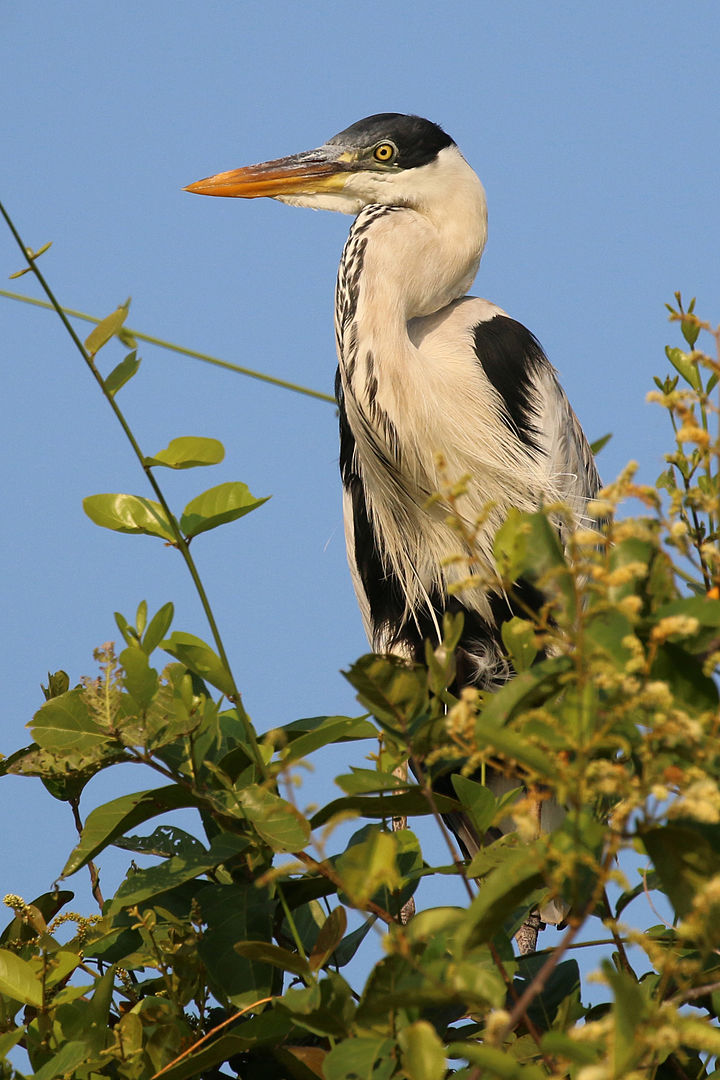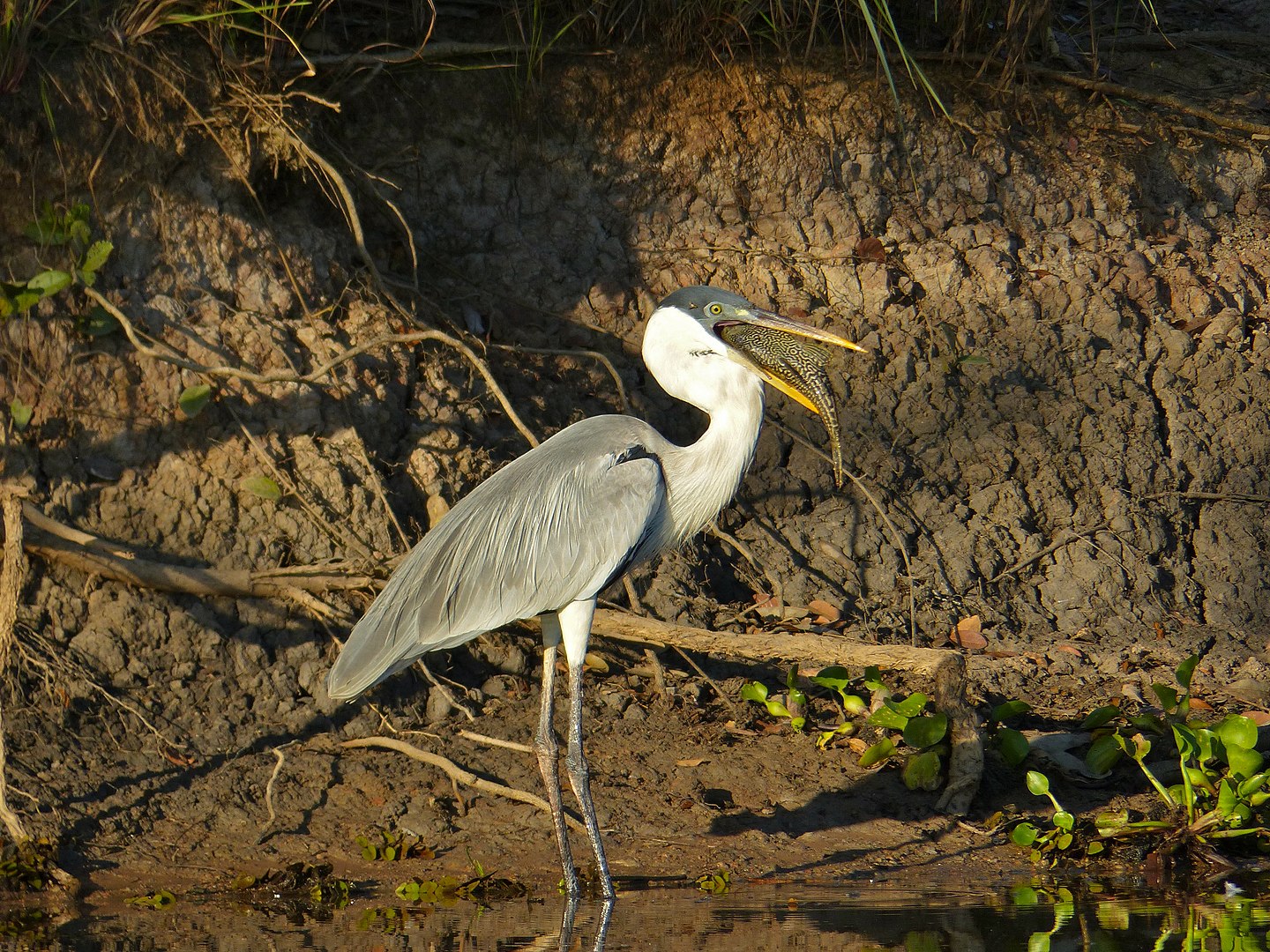The Cocoi heron is the largest of the South American herons. In many parts of its range, the Cocoi heron is the most common and easy to see heron, as it forages in the open, and occupies a large range of habitats where there is water. The large size; long, all-white neck with a black cap makes this bird distinctive throughout its range. Though young birds may appear similar to the closely related Great Blue heron (Ardea herodias), they always show the distinctive dark cap that comes down below the eye. Read on to find out more fascinating details about this unique bird.
Features Of The Cocoi Heron
- Length & Weight –
 The Cocoi heron measures 95–130 cm (37.5–51 in) in length, although body sizes vary regionally; with southern individuals probably being the largest. Adult weight of both males and females can variously range from 1.14 to 3.2 kg (2.5 to 7 lb).
The Cocoi heron measures 95–130 cm (37.5–51 in) in length, although body sizes vary regionally; with southern individuals probably being the largest. Adult weight of both males and females can variously range from 1.14 to 3.2 kg (2.5 to 7 lb). - Wing Length – In the adult, wing length has been recorded as 421–455 mm (16.5–18 in), tail length 161–173 mm (6.5–7 in), culmen from base 128.5–148.7 mm (5–6 in) and tarsus 179–192 mm (7–7.5 in).
- Body Color – The sexes are alike in both body size and coloration. It has a grey back and upper wings and a white S-shaped neck, thighs, under-tail wing coverts and scapulars; with black streaks on the neck and upper breast.
- Forehead Color – The forehead and crown of the head are black and this black extends down to the eye region and up to the pointed crest hanging down the nape. There is also black streaking on the neck and black patches on sides of the lower breast and abdomen.
- Leg & Iris Color – Leg color has been reported as black, brownish-grey or dark green. The iris is usually yellow and the bill dull yellow. The bare skin of the orbital region is pale greenish.
- Juvenile Color – In the juvenile, the underparts are ash grey and streaked with buff. The neck and upper body surface are pale brownish with some ash grey tinge on the neck. Compared to the adult, the crown is duller and the under-tail coverts have a dusky streaking. Juveniles also lack the long plumes and occipital crest typical of the adult.
Scientific Classification Of The Cocoi Heron
Cocoi Heron – Ardea cocoi [Scientific name]
- Kingdom: Animalia
- Phylum: Chordata
- Class: Aves
- Order: Pelecaniformes
- Family: Ardeidae
- Genus: Ardea
- Species: A. cocoi
Habitat Of The Cocoi Heron
The Cocoi heron occurs throughout much of South America except in the Andes and in some parts of Argentina. It is native in Argentina, Panama, Suriname, Colombia, Venezuela, Bolivia, Brazil, Chile, Ecuador, French Guiana, Guyana, Paraguay, Peru and Uruguay. Overall, the Cocoi heron is notably widespread and ranges from Central America to the mainland shores on the Strait of Magellan, but is rarely found further south than Chubut in Argentina. The habitat comprises almost any body of water or wetland away from dense forest; including lake shores, swamps, rivers and estuaries. Gallery forest, grassland and beaches have also been reported to be suitable feeding grounds.
Diet Of The Cocoi Heron
It generally feeds alone and defends its feeding territory. It also joins large mixed species aggregations, especially during the drying season. In such situations it not only forages for itself but also robs prey from other species, such as Wood Storks (Gonzalez 1996). Its diet is primarily large fish, fish species consumed include whitemouth croaker, wolf fish, various Leporinus species up to 200 mm long and streaked prochilod. This heron has also been observed to feed on carrion and Callinectes blue crabs. The heron also eats frogs and the larvae of aquatic insects. Fish can be up to 30 cm long. It probably has a broad diet, for example eating dead crabs.
How They Catch Prey: The Cocoi heron catches prey by striking its head into the water and thrusting its bill to stab downwards. It may also tilt its head downward above the water so that only its bill is immersed. During feeding, the head and neck move rapidly while the body remains immobile.
Reproduction Of The Cocoi Heron
This heron is primarily non-migratory, but may move toward the equator during winter to seek warmer temperatures. The onset of the nesting season varies geographically. The Cocoi heron nests colonially in trees. The large, deep nest is constructed from branches and sticks with grass, usually situated in trees. Near Buenos Aires, nests consisted of branches of Solanum glauca and dry thistles. They were roughly circular, 65 cm in diameter and very deep. In Chile, Cocoi herons have been observed to construct their nests on weeping willow trees in standing water with rushes. Generation length in years has been estimated as 10.5 years, with a maximum longevity of 24.4 years.
Eggs: The eggs are pale blue with paler speckles and some whitish traces. Egg dimensions from various clutches in South America lie in the range 62-69 x 45-48 mm. Eggs from one Argentinian clutch weighed 70-80 g. From one colony in Buenos Aires, incubation was estimated as 24-26 days. However, in one Chilean colony where eggs hatched in September (Spring), incubation period was estimated as 27 days, ranging 26-29 days. Clutch size is 1 to 4 eggs. Juveniles may remain in the nest for up to 12 to 13 weeks, but most leave at 6 to 7 weeks.
Five Facts About The Cocoi Heron
- In flight, its large wings make it a slow but sturdy and graceful flyer.
- The voice is a deep croak.
- Overall, the Cocoi heron is similar in appearance to the grey heron; but the former has slightly darker coloration and a longer neck and crest.
- The Cocoi heron utters guttural calls, either at roost and at colonies, or in flight “gawk uk, guk uk, guk uck uck” in more or less long series.
- Usually shy, it is often solitary, but occasionally, it may forage in large groups of birds. It may feed both by day and night according to the range. They gather at roosting sites in trees or reedbeds, where they utter their typical guttural calls.
Cocoi Heron In Guyana
As you would have read, the Cocoi heron is a large, generally solitary bird that feeds principally in grassy marshes and other wetland situations. Typical of the large herons, it is a patient feeder, foraging alone and defending its territory from other herons. But when prey is abundant, it joins into aggregations and feeds socially. As is typical of the other large Ardea, it feeds on a wide variety of prey, some rather large. But much remains to be documented about this abundant and conspicuous species that could well serve as an emblematic species of South American wetlands.
Article References:
- https://en.wikipedia.org/wiki/Cocoi_heron
- https://neotropical.birds.cornell.edu/Species-Account/nb/species/cocher1/overview
- http://www.oiseaux-birds.com/card-cocoi-heron.html
- https://www.heronconservation.org/herons-of-the-world/list-of-herons/cocoi-heron
- Main Image: By Bernard DUPONT from FRANCE – Cocoi Heron (Ardea cocoi) eating a Sailfin Catfish (Pterygoplichthys sp.), CC BY-SA 2.0, https://commons.wikimedia.org/w/index.php?curid=56063914
Discover more from Things Guyana
Subscribe to get the latest posts sent to your email.








2 Comments